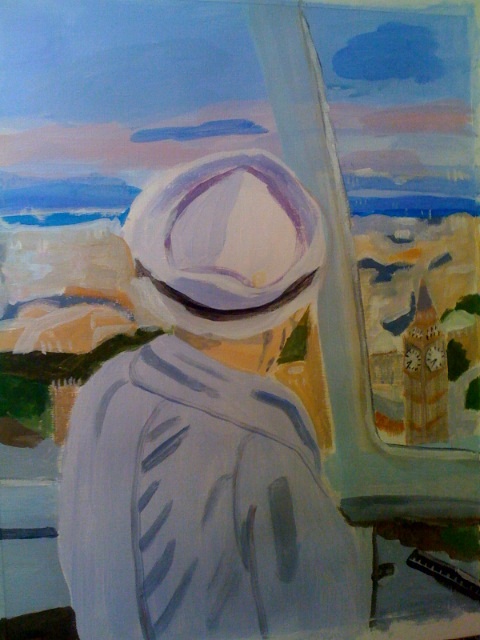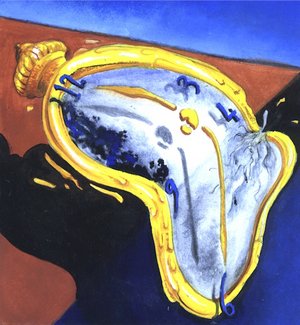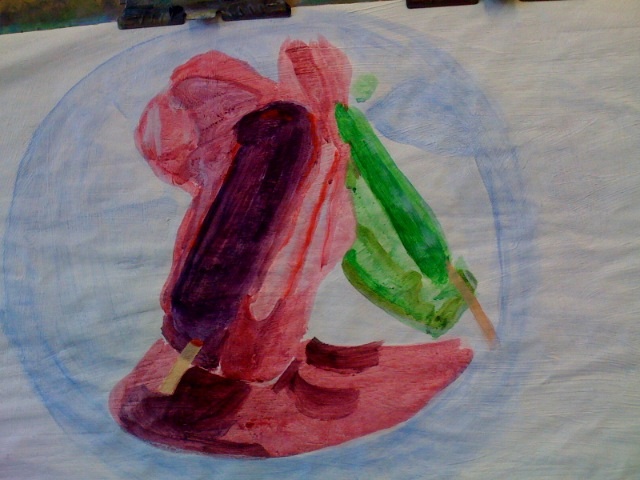
Homework Assignment for Intro to Painting, Spring 2008.
Jenny Bowen Forde at 99 on London Eye: Painted March 5, 2008 from photograph. Acrylic on paper 14 x 18
I would not have believed that I could render this painting in the way that I have. It took a life of its own, and Jenny B came alive in the scene. The assignment was to take a photograph of a window, and paint it showing both inside and outside. This photograph was taken in 2005 and was an amazing shot of my mother surveying London from the pod of the London Eye.
The most difficult was getting started. How to, what to, where to etc. etc. Then I just started, drawing a grid on the photograph and on the paper. I wasn't sure how to start, whether to draw the images first and then paint, or to just start painting. Before I knew it, I began painting shapes of the same colour as in a "painting by numbers" painting. I painted the largest shapes first and was amazed to see how the human figure emerged. The hat should have been a bit more rounded at the top, and not peaked, but the hat is her hat, the head her head, the turn of the neck her attitude, and the curved back, her 99 year old dowager humped back, still regal in her summer silk coat.
Someone at class said it looked like the Queen looking down at Big Ben. She is a regal lady and I'm still amazed how well her attitude was captured...well, I copied the photograph, but still, I'm delighted at how this first attempt turned out.
I didn't know what to do with the scenery in the horizon outside the window. There was too much detail and I didn't know where to begin. So I squinted my eyes, saw the dark shapes and began the "painting by numbers" approach. A blob of paint here, another dark shape that looked like a bird over there, and bit by bit, the scene emerged. Amazing. I chose to exclude details of all the buildings except Big Ben on right and a little bit of Parliament buildings on her left.
The sky emerged as well, as I moved in my painting by "numbers" approach, finding where the same colours were located in the grids across the page. The perspective of the window frame was a bit tricky until I began to pay attention to the angles and differing widths between the right and left of the picture.
It worked...amazing...how do you draw glass? You don't! You draw what you see, and everything emerges.
So I've decided that the artist must first deconstruct the images in order to reconstruct the painting. Bit by bit, the deconstructed pieces are laid down on the canvas/paper, and the brain then pulls those pieces together to create a recognisable whole. Is this how the brain works when we look at anything, and perhaps in painting, we are slowing the process down enough so that each step of "seeing" becomes a separate observable operations.
Much like a toddler beginning to walk...each step is deliberate, shaky sometimes, but distinct and separate from the overall automatic procedure of walking. Automaticity is not yet present.
In the beginning reader, automaticity is not there. In the young person learning their multiplication tables, automaticity is not there. The artist, experienced or novice, works in a similar way. There is no automatic act of rendering an image unless you are a camera. The act of drawing or painting, requires the accumulation of a number of steps, shapes, colours, angles, bits and pieces of the whole which the brain pulls back together into a composite whole.
An artist has to be able to see parts within the whole. The artist must break Humpty Dumpty into little pieces and have a strategy for putting Humpty Dumpty together again. The strategies for putting the pieces together to make the whole, are what a skilled art teacher can convey to anyone, whether artistically "challenged" or supposedly "gifted".
Drawing & Painting is about seeing, about understanding and recognising relationships which are in essence mathematical relationships. Ratio and proportion, angles compared to a horizontal or vertical, and recognising the basic shapes, circles and ellipses, triangles, quadrilaterals and the combination of these.
You also begin to see light and dark, shades, shadows and hues.
This was great fun. Nothing like having the evidence that one is actually seeing. How do we translate this into "seeing" with the spiritual eye, and differentiating the real from the not real.
This was a priviledge to paint my now 102 year old mother and to see her and her hat, emerge. One more thing...I used the analogy of the "melting lollipop" to get going, and gave myself three 45 minute time slots to complete the painting. Not only did I paint by numbers, but I painted by alarm clock.. It worked.!


